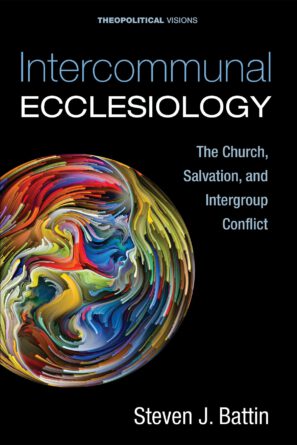Steven J. Battin: Intercommunal Ecclesiology
Steven J. Battin: Intercommunal Ecclesiology. The Church, Salvation, and Intergroup Conflict, Theopolitical Visions 27, Eugene, OR: Cascade Books, 2022, Pb., XI+243 S., € 29,–, ISBN 978-1-7252-5608-8
The title, “intercommunal ecclesiology” piqued my curiosity. Usually ecclesiologies define particular Christian traditions. If this ecclesiology aims to provide a bridge between Christian traditions, why not simply write “ecumenical ecclesiology”? This study takes “intercommunal” in its broadest sense, as an ecclesiology that locates the Church amidst all other human communities in our societies. The author, an Afro-American Roman Catholic, sensitive to injustice and inequality by virtue of his own biography, signals the nearly inescapable conflict and violent interrelatedness of human groups, often including the church. Writing from “the underside of modernity,” he seeks to complete “the unfinished project of decolonization” (18–19). His guiding questions are, what is God’s purpose in creating yet another human group amidst all the others? What is God’s soteriological intention in creating this new community, the Church?
The project proceeds in three phases. Phase one investigates intergroup relationships. Phenomenologically, the Church is one among many human groups, with its own distinctive culture, beliefs and practices. At the group level, “sin” is not primarily an individual, interior conception but a mechanism of moral exclusion as a major cause of violent intergroup relatedness. “Moral exclusion occurs when individuals or groups are perceived as outside the boundary in which moral values, rules and considerations of fairness apply” (20–21). Moral exclusion functions at the biopsychosocial level to shape our in/outgroup perception, our belonging and self-identity, and our parochial altruism. This mechanism underlies the dynamics of inequality and discrimination, and may be triggered by persecution or trauma. It may lead to infrahumanization, the tendency to perceive ingroup members as more human than outsiders, often a precursor to outgroup violence. Such forces in church history actively shaped the perception of “Church.”
Phase two explores salvation as a human experience in a disclosive divine encounter. Such “originary experiences” shape the life-world of all religious groups, but with the rise of modernity, Christians began to view all others as not having true access to the divine. This engendered Western infrahumanization, leading to intergroup violence. Salvation, then, is God’s response to this intergroup violence, which is not primarily a doctrine or belief, but a theologal event in which divine and human action flow together. Salvation pertains “to the preservation of life and the creation of right interrelationship” (108) and is a patterned series of events. As testified in the Exodus as well as in Jesus’ ministry, God hears and sees the problem, God takes decisive action to restore life and right relationships, along with human co-agents, and in a concrete historical process full of eschatological hope. This structure of salvation becomes the protocol of intergroup interaction for God’s new community, the Church, participating in the divine ministry of reconciling the world.
Phase three connects the argument with the identity and mission of the church. The church’s identity is formed in the originary experience of Jesus and the human group he initiated. Pentecost provided the theological affirmation and spiritual empowerment of this community, as it moved into the world. Christ acted to ‘save’ this community in Paul’s Damascus Christophany, to bring life and right relatedness through the Church to the world. Here, Paul discovered the reality of the Church as Christ’s Body, indicating that the Church is Christ’s collective embodiment to participate in Christ’s ministry of reconciliation for the world. Battin’s study offers a phenomenological ecclesiology for understanding the identity and purpose of the church at the intersection of social psychology, biblical studies and early (eastern) patristics. His approach fits well with practical theological attention to human experience and groups. The church as the Body of Christ is God’s co-agent in bringing salvation to the world. Battin thus positions the Church as God’s response to the problem of violent intergroup relatedness. His approach aligns nicely with an incarnational, missional ecclesiology, although he does not use missional language.
Jack Barentsen, Professor Practical Theology, Evangelische Theologische Faculteit, Leuven (Belgium)
